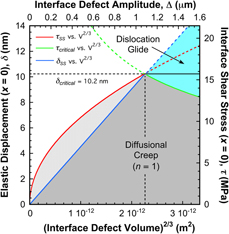Crossref Citations
This article has been cited by the following publications. This list is generated based on data provided by
Crossref.
Krauskopf, Thorben
Richter, Felix H.
Zeier, Wolfgang G.
and
Janek, Jürgen
2020.
Physicochemical Concepts of the Lithium Metal Anode in Solid-State Batteries.
Chemical Reviews,
Vol. 120,
Issue. 15,
p.
7745.
Wang, Yikai
Dang, Dingying
Xiao, Xingcheng
and
Cheng, Yang-Tse
2020.
Structure and mechanical properties of electroplated mossy lithium: Effects of current density and electrolyte.
Energy Storage Materials,
Vol. 26,
Issue. ,
p.
276.
He, Yaolong
Li, Shufeng
Zhou, Sihao
and
Hu, Hongjiu
2020.
Mechanical Integrity Degradation and Control of All-Solid-State Lithium Battery with Physical Aging Poly (Vinyl Alcohol)-Based Electrolyte.
Polymers,
Vol. 12,
Issue. 9,
p.
1886.
Wang, Michael J.
Chang, Jiun-Yeu
Wolfenstine, Jeffrey B.
and
Sakamoto, Jeff
2020.
Analysis of elastic, plastic, and creep properties of sodium metal and implications for solid-state batteries.
Materialia,
Vol. 12,
Issue. ,
p.
100792.
Liu, Qiunan
Zhang, Liqiang
Sun, Haiming
Geng, Lin
Li, Yanshuai
Tang, Yushu
Jia, Peng
Wang, Zaifa
Dai, Qiushi
Shen, Tongde
Tang, Yongfu
Zhu, Ting
and
Huang, Jianyu
2020.
In Situ Observation of Sodium Dendrite Growth and Concurrent Mechanical Property Measurements Using an Environmental Transmission Electron Microscopy–Atomic Force Microscopy (ETEM-AFM) Platform.
ACS Energy Letters,
Vol. 5,
Issue. 8,
p.
2546.
Mistry, Aashutosh
and
Mukherjee, Partha P.
2020.
Molar Volume Mismatch: A Malefactor for Irregular Metallic Electrodeposition with Solid Electrolytes.
Journal of The Electrochemical Society,
Vol. 167,
Issue. 8,
p.
082510.
Fincher, Cole D.
Ojeda, Daniela
Zhang, Yuwei
Pharr, George M.
and
Pharr, Matt
2020.
Mechanical properties of metallic lithium: from nano to bulk scales.
Acta Materialia,
Vol. 186,
Issue. ,
p.
215.
Nagy, Kyle S.
and
Siegel, Donald J.
2020.
Anisotropic Elastic Properties of Battery Anodes.
Journal of The Electrochemical Society,
Vol. 167,
Issue. 11,
p.
110550.
Fincher, Cole D.
Zhang, Yuwei
Pharr, George M.
and
Pharr, Matt
2020.
Elastic and Plastic Characteristics of Sodium Metal.
ACS Applied Energy Materials,
Vol. 3,
Issue. 2,
p.
1759.
Veeraraghavan, Vijay D.
Frenck, Louise
Maslyn, Jacqueline A.
Loo, Whitney S.
Parkinson, Dilworth Y.
and
Balsara, Nitash P.
2021.
Evolution of Protrusions on Lithium Metal Anodes Stabilized by a Solid Block Copolymer Electrolyte Studied Using Time-Resolved X-ray Tomography.
ACS Applied Materials & Interfaces,
Vol. 13,
Issue. 23,
p.
27006.
Albertus, Paul
2021.
Soft and liquid metals.
Nature Energy,
Vol. 6,
Issue. 3,
p.
225.
Pang, Mei-Chin
Yang, Kai
Brugge, Rowena
Zhang, Teng
Liu, Xinhua
Pan, Feng
Yang, Shichun
Aguadero, Ainara
Wu, Billy
Marinescu, Monica
Wang, Huizhi
and
Offer, Gregory J.
2021.
Interactions are important: Linking multi-physics mechanisms to the performance and degradation of solid-state batteries.
Materials Today,
Vol. 49,
Issue. ,
p.
145.
Carmona, Eric A.
Wang, Michael J.
Song, Yueming
Sakamoto, Jeff
and
Albertus, Paul
2021.
The Effect of Mechanical State on the Equilibrium Potential of Alkali Metal/Ceramic Single‐Ion Conductor Systems.
Advanced Energy Materials,
Vol. 11,
Issue. 29,
Kalnaus, Sergiy
Westover, Andrew S.
Kornbluth, Mordechai
Herbert, Erik
and
Dudney, Nancy J.
2021.
Resistance to fracture in the glassy solid electrolyte Lipon.
Journal of Materials Research,
Vol. 36,
Issue. 4,
p.
787.
Papakyriakou, Marc
Lu, Mu
Liu, Yuhgene
Liu, Zhantao
Chen, Hailong
McDowell, Matthew T.
and
Xia, Shuman
2021.
Mechanical behavior of inorganic lithium-conducting solid electrolytes.
Journal of Power Sources,
Vol. 516,
Issue. ,
p.
230672.
Wang, Michael J.
Kazyak, Eric
Dasgupta, Neil P.
and
Sakamoto, Jeff
2021.
Transitioning solid-state batteries from lab to market: Linking electro-chemo-mechanics with practical considerations.
Joule,
Vol. 5,
Issue. 6,
p.
1371.
Mallakpour, Fereshteh
Kasraie, Masoud
Herbert, Erik G.
Phani, P. Sudharshan
and
Hackney, Stephen A.
2021.
Length-scale-dependent stress relief mechanisms in indium at high homologous temperatures.
Journal of Materials Research,
Vol. 36,
Issue. 12,
p.
2444.
Wang, Hongchun
Gao, Haowen
Chen, Xiaoxuan
Zhu, Jianping
Li, Wangqin
Gong, Zhengliang
Li, Yangxing
Wang, Ming‐Sheng
and
Yang, Yong
2021.
Linking the Defects to the Formation and Growth of Li Dendrite in All‐Solid‐State Batteries.
Advanced Energy Materials,
Vol. 11,
Issue. 42,
Raj, Rishi
2021.
Stack Pressure and Critical Current Density in Li-metal Cells: The Role of Mechanical Deformation.
Acta Materialia,
Vol. 215,
Issue. ,
p.
117076.
Vadhva, Pooja
Boyce, Adam M.
Hales, Alastair
Pang, Mei-Chin
Patel, Anisha N.
Shearing, Paul R.
Offer, Gregory
and
Rettie, Alexander J. E.
2022.
Towards Optimised Cell Design of Thin Film Silicon-Based Solid-State Batteries via Modelling and Experimental Characterisation.
Journal of The Electrochemical Society,
Vol. 169,
Issue. 10,
p.
100525.


